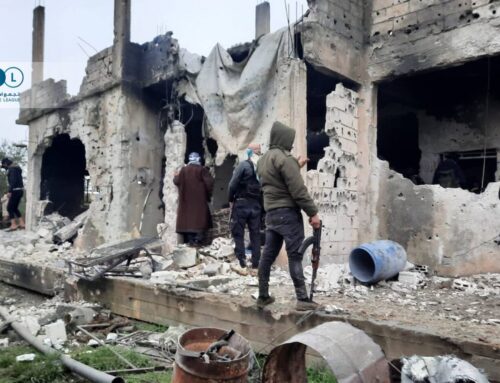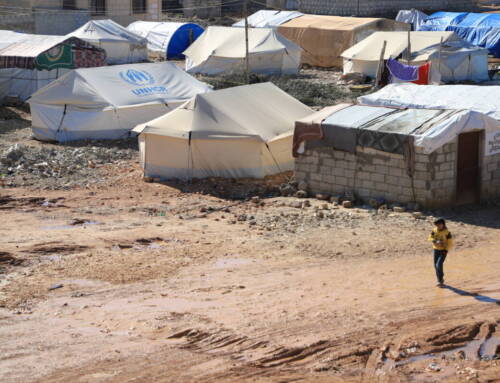From ally to traitor: The US deserts partner east of the Euphrates
The Turkish operation marked a turning point in the fate of the entire region east of the Euphrates.
28 October 2019
AMMAN—In the summer of 2017, as American troops deployed to the border with Turkey following violent clashes between the Turkish military and the Kurdish People’s Protection Units (YPG), activist Masoum Muhammad held a placard welcoming them to the city of Amuda in northeastern Syria. “Washington: Amuda is with you until death!” the placard read.
Muhammad and other residents east of the Euphrates never thought they would be abandoned by their American ally until US President Donald Trump announced the withdrawal of American troops on October 7, allowing Turkey’s “Operation Peace Spring” to begin.
Turkey, relying on the Syrian opposition Syrian National Army (SNA), launched the military operation under the pretext of eliminating the terrorist threat posed by the YPG, which Ankara considers to be an extension of the Kurdistan Workers’ Party (PKK)— designated as a terrorist organization by both Turkey and the US.
The Turkish operation marked a turning point in the fate of the entire region east of the Euphrates, Muhammad told Syria Direct.
“If I saw the [American] military vehicles withdrawing, I would say ‘Amuda will not forgive you,’” Muhammad said, adding that “the Kurdish people viewed the Americans as a permanent supporter and ally, especially after the defeat of the Islamic State (IS), but after they permitted Turkey to wage war against us, our view changed to hatred and resentment of them. They betrayed the Kurds and the [Syrian Democratic Forces] SDF, which sacrificed their youth for the sake of freedom from IS.”
Since 2012, the Autonomous Administration of North and East Syria (AA), whose foundation was subsequently announced by the Kurdish Democratic Union Party (PYD) in 2013, has controlled areas east of the Euphrates.
Since October 2015, the AA expanded its political, administrative, and military influence through a partnership between its military wing—the SDF— and the US in order to combat IS. As a result, the AA expanded its control from Hasakah province to cover approximately 30% of Syria’s territory, in the north and east of the country.
This partnership distanced the region from the fierce conflicts between government and opposition forces that took place in other parts of Syria, turning it into one of the country’s most secure and stable areas by comparison.
But as the Turkish army and the SNA advanced toward the SDF-held city of Tal Abyad, just across the border from Turkey in the Syrian province of Raqqa, the SDF and the government in Damascus came to an agreement moderated by Russia, that allowed government forces to enter and control SDF-held areas.
As a result, the areas in northern and eastern Syria have become divided between SDF, the Turkish-backed opposition forces and Russian and Syrian government forces. This, consequently, has aroused fear and anxiety among citizens, who fear the Turkish-backed and Syrian government forces.
Thus, while areas affiliated with “American influence” were once safe, Shafan Omar (pseudonym), from the city of Qamishli, feels “insulted,” and more importantly, “afraid of the unknown that awaits the region,” as many others do. “The region is not stable anymore, and we await displacement at any moment,” he said.
“The entry of the regime forces means that no young man will remain in the area for fear of being persecuted by security services or forced to join the army,” he told Syria Direct, and asked: “Do the Americans realize what they did to us? Did we deserve all this?”
Government forces were deployed along the border between Syria and Turkey in the cities of Amuda and al-Derbasiyah, from which SDF forces withdrew under Russian air cover. But the SDF issued a statement on Sunday, October 27, asserting “institutions will remain under the supervision of the AA.”
As such, a batch of US troops returned to Syrian territory days after their withdrawal to Iraq, to station in the eastern countryside of Deir e-Zor.
It is noteworthy that US forces withdrew from northern Syria in Ain Issa, north of Raqqa, and Tabqa airport in the south of Raqqa, and the base of Kharab Ashak in the countryside of the city of Ain al-Arab (Kobane), and maintained its presence in the province of Hasakah and rural eastern Deir e-Zor.
But for activist Masoum Muhammad, people of the region have lost faith in US forces and the US troops return to the region has not changed their opinion.
“Unfortunately, we became guards for the oil,” one SDF fighter who worked with US forces said, referring to a tweet by President Trump on October 24: “Perhaps it is time for the Kurds to start heading to the oilfields,” to prevent IS fighters from taking control of it.
The fighter told Syria Direct that US troops “are sad about the decision, but the decision is political.”
This report was originally published in Arabic and translated into English by Calvin Wilder and Nada Atieh.







